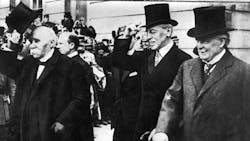Our Opportunity to Breathe Real Change Into History
As we now ready ourselves for a new year closer to normal, the “before times” seem finally to be returning, albeit in a forever altered form.
Of course, we don’t know what all the long-term effects will be of the last few years. We are told that students of just about every age are showing the ill effects of isolation and distancing in ways that suggest setbacks in socializing and emotional development. Depression is on the rise. And in many places, for people of all ages and occupations, there remains the inescapable sense that things are still, well, different.
Granted, as the uber-vaccinated spouse of an elementary school teacher, I firmly believe that social distancing, remote learning, and vaccinations and boosters during this persistent global pandemic have all been necessary and have saved hundreds of thousands, if not tens of millions, of lives, worldwide.
But after-effects remain, of course, and several are much broader than we can even imagine.
Indeed, the influence on history of The Great Influenza of 1918 has been vastly underappreciated. Just as World War I was ending, that pandemic emerged to infect more than half a billion humans, and kill roughly 50 million. (To date, COVID-19 has claimed some 6.6 million lives globally.) Yet, even with those jaw-dropping numbers, its most consequential victim may have been President Woodrow Wilson, who in 1919 was incapacitated during peace treaty talks in France, rendered ineffective as a participant, and then unable to rally support at home for his League of Nations. The result was a disastrous and punitive Treaty of Versailles that historians now agree planted the seeds of the even more devastating WWII.
Unintended consequences.
It begs the question of what will come out of this pandemic that we cannot quite foresee at the moment?
Toward that end, our industry now still has before it the massive opportunity to forge a true global renaissance of indoor air quality (IAQ) management. This would be a hugely consequential “paradigm shift” that would both improve public health and also bolster the uncertain future of commercial construction and renovation.
With that in mind, even as it currently seems focused more on decarbonization (Earth’s other front-burner issue), ASHRAE this fall just released new guidance on Infectious Aerosols. The updated Positions Document is an important effort that seeks to keep owners and developers focused on public safety moving forward. But that is a task easier said than done. In this golden era of shorter and shorter attention spans, we now have to try even harder to remain focused on goals that require us to actually do things differently.
“As the saying goes, ‘You can lead a horse to water, but you can’t make him drink,’” laments Dr. Bill Bahnfleth, P.E., former ASHRAE President, and former chair of the society’s emergency Epidemic Task Force (ETF), which ended its work last June. He is still Vice Chair of ASHRAE’s Environmental Health Committee, which he says will now carry the work forward of the ETF.
Even after all he has seen in the last two-and-a-half years, however, which included his own breakthrough bout of COVID earlier this year, Bahnfleth remains hopeful that real progress is being made toward healthier buildings. (For much more, listen to our new podcast with Bahnfleth here.) “The field is shifting, but sometimes it’s hard to see that happening early on,” he says.
Indeed, it’s nice to be reminded that some hidden consequences can also be positive.
Let us hope that the new year may be filled with only such pleasant surprises.
##########
About the Author
Rob McManamy
Editor in Chief
An industry reporter and editor since 1987, McManamy joined HPAC Engineering in September 2017, after three years with BuiltWorlds.com, a Chicago-based media startup focused on tech innovation in the built environment. He has been covering design and construction issues for more than 30 years, having started at Engineering News-Record (ENR) in New York, before becoming its Midwest Bureau Chief in 1990. In 1998, McManamy was named Editor-in-Chief of Design-Build magazine, where he served for four years. He subsequently worked as an editor and freelance writer for Building Design + Construction and Public Works magazines.
A native of Bronx, NY, he is a graduate of both the University of Virginia, and The John Marshall Law School in Chicago.
Contact him at [email protected].
